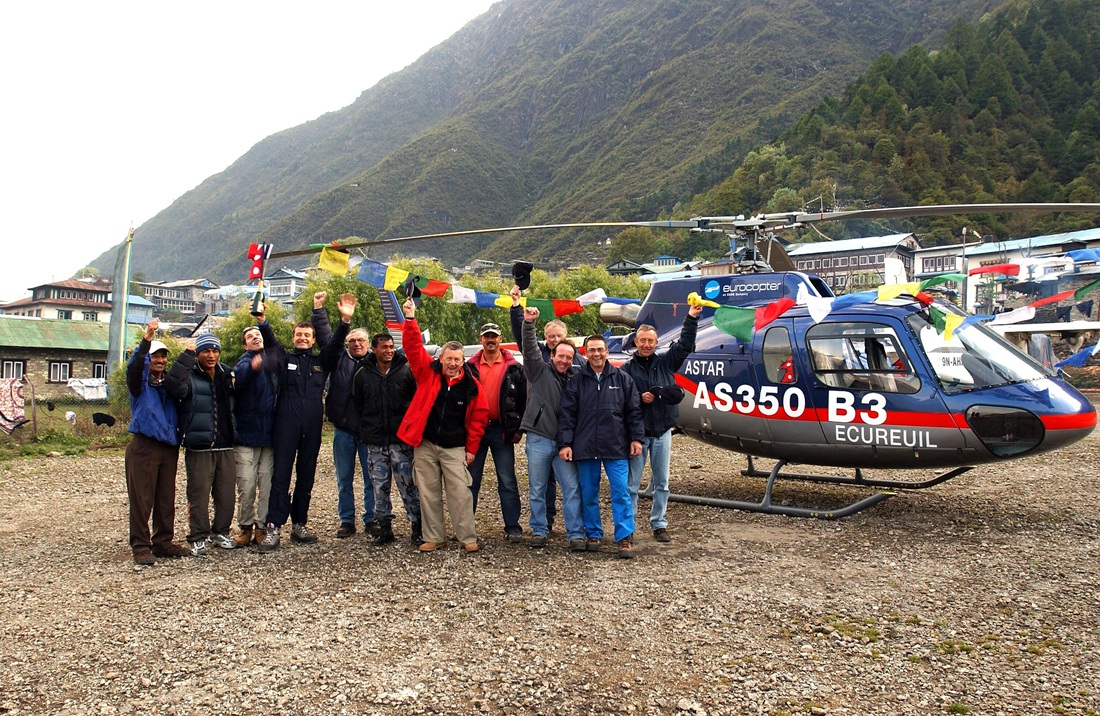"The mountain will show you her mighty forces" Heli pilot Didier Delsalle 20th anniversary Everest flight interview
Twenty years ago on 14 May 2005, Didier Delsalle flew an Ecureuil AS 350 B3 helicopter to the top of Everest and gained an FAI World Record for highest take-off in a helicopter at 8848m.
To mark the 20th anniversary of the achievement, Delsalle participated in an interview with FAI:
You trained in Chambéry, in the French Alps. Has flying in the mountains always held a special appeal, or feeling of respect towards the environment?
Yes, my initial training as helicopter military pilot was in Chambery Airbase in 1980-81 and for sure it induced an everlasting appeal for mountain flying! Flying helicopters in the mountains is pure delight, more a sentimental dance than a strong powerful technical move. Flying in high mountains should be considered as a privilege to be used with great respect to the environment.
The first thing you need to learn in mountain flying is that you must know and respect the mountain, that you have to make very gentle deals with her and be “accepted” there. If you try to force her with brute force, you will for sure be seriously and abruptly disappointed one day, sooner or later… You are only a visitor there, not the owner.
The mountain will show you her mighty forces and you have to accept and cope with them. Along Everest’s cliffs, as an example, I discovered what I thought was unimaginable: climbing autorotation!? With no power from the engine, the helicopter was sometimes pushed up for several minutes by incredible updrafts with no way to approach any landing spot. So then you can imagine what flying conditions were like once entering the downdraft areas! Avoidance is the only option…
Is the Everest record one of your proudest achievements?
Yes, of course! Except that I am not specifically proud of myself, but of all the engineers and technicians that conceived and built this wonderful machine! They fully deserved this recognition because they are rarely in the spotlight.
Pilots use their skills to drive the machine, but without the rest of the team, nothing would have had happened. Part of aircraft manufacturers’ experimental test pilots’ jobs is to demonstrate a lot of difficult and tricky certifications points in flight, so that makes them proud of their job. The same goes for me.
The Everest mission was one that made a major impression on the public and the customers, but it is, for me, one proud moment among several other very memorable ones…

When you look back at the Everest project, what are your main memories after 20 years?
The two main points I have in my memory are firstly, the tremendous difficulties I had to get cleared for the project, to organise the logistics and diplomatic side, and secondly, once we were there, the impressive power of nature, which can cut power on any flying machine in a second, if you are not on permanent alert!
The technical flying part was, I would say, not easy but quite manageable for an experimental test pilot. Opening new flight envelopes and flying at the limits are the root of our job. Initially the company was not keen at all to let me attempt the flight, because of the personal risk level and the potential damage that could affect the company reputation in case of a failure or accident.
We also had a very tight budget, i.e. no pre-travel to organise the mission in Nepal so it was not very easy to prepare all the logistic aspects of the mission: transport, lodging, helicopter fuel, flight clearances, etc.
Then I think of the teamwork created with the people who helped me (mainly for free on extra hours!) to demonstrate technically that the risk level was acceptable, and then helped prepare and maintain the helicopter. I made friends for life!
What do you think have been the benefits of pushing the boundaries of helicopter performance in the environment of the Himalayas?
Firstly, we proved that there is no location on Earth that cannot be reached by helicopter. We also demonstrated to helicopter operators the margins they have, when they operate their machines in the certified flight envelope. Also, taking in account the poor conditions in which we were operating in Lukla – no hangar, no ground assistance, the reliability of the aircraft in such harsh environment – we did not have a single failure during the whole mission!
Of course, we still do not have helicopters authorised to fly rescue missions above 7000m, but since Everest, we have improved the AS350 B3 (known nowadays as the H125 Power) for “hot and high” altitude missions. To certify a helicopter able to perform rescue missions around 8000m or above would induce considerable certification efforts, but we proved it is possible.
As a conclusion, the summits above 8000m are definitely not a place for air tourism. Even if such a rescue machine exists in the future, it will remain a very difficult and tricky achievement with no guarantee of success at all, because the forces of Nature you encounter at that altitude might prevent any type of helicopter or flying machine, the environment is so extreme.

Image credits (c) Airbus Helicopters - Photo: Patrick Penna, May 2005

